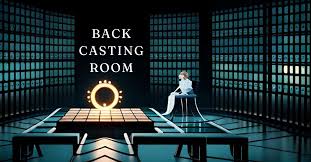Table of Contents
- Introduction to Back Casting Room
- What is Back Casting Room, and How Does it Differ from Forecasting?
- Benefits of Using Back Casting Room for Future Planning
- Real-Life Examples of Successful Back Casting Room Strategies
- Tips for Utilizing Back Casting Room Effectively
- Alternatives to Back Casting Room
- Conclusion:
- FAQs:
Introduction to Back Casting Room
Back Casting Room: Think about being able to dictate your future by using the desired result and working your way back.
This is precisely the procedure where does the Back Casting Room and how it changes the usual perception of planning and decision making.
Planning, per se, often employs a more common view where one forecasts a trend or behavior by looking at historical data, while back logic does the opposite.
This involves imagining a desirable outcome first and then figuring out the steps required to achieve that outcome.
The usefulness of such broad appreciation, especially who are or which world Subordinates will prove the people’s worth, reverberates well when accountability is gone.
In other words, the Tactical planning Room is a cloud of how more resources can help with strategic considerations and visions.
Along with strategic planning, this goes beyond connecting the orders on model management and ring coordination, which is essential in a catastrophic decision chain.
Therefore, let us examine why the Back Casting Room is a must-admit resource. or any forward-thinking organisation looking to thrive in tomorrow’s landscape!
What is Back Casting Room, and How Does it Differ from Forecasting?

Back Casting Room is a new-age planning perspective in that it does not attempt to forecast what will happen in the future; instead, it deals with explaining what has already transpired.
Essentially, it works backward from a specific objective or intended outcome to be achieved rather than looking forward and making predictions.
This approach is very different from forecasting. This is what forecasting has always wanted to be: taking current information and attempting to predict the future.
On the one hand, forecasting uses available data to foresee and project a possible outcome; on the other hand, backcasting facilitates a paradigm change, defining where one wishes to be and figuring out what should be done to reach that point.
Clarifying the end state and vision would make focusing on the organization’s strategies and resources easier.
This would also help frame questions about what could have been done differently in the past and what lessons from the past would be relevant to future actions.
More so, focus would be given to the path taken to achieve the outcomes rather than predicting the outcomes with clusters of unknowns.
The Back Casting Room encourages strategic thinking and planning without being restricted to prognostication models.
Teams can strategize on how to reach specific targets realistically rather than plan on how they will be able to predict the future.
Benefits of Using Back Casting Room for Future Planning
Using a Casting Room can significantly improve strategic management. It shifts the emphasis from projecting the future toward setting the required outcomes.
Such an initiative will help organizations stay active and pursue their objectives strategically.
Starting at the end allows the teams to break down the goals and identify the critical milestones and steps needed to achieve them.
This eases the process of making relevant choices and arranging the various tasks.
In addition, the clarity results in increased flexibility. If the situation changes and certain things are needed, the strategies can be altered quickly without compromising the end goals.
Effective use of a Back Casting Room creates conditions where people appreciate the need to incorporate different views in developing strategies.
Each individual possesses different information that would help in the planning process, enhancing ideas and originality.
This method makes using measurable outcomes far easier.
Since clear parameters can be set for the desired result, making progress is effortless and efficient.
Real-Life Examples of Successful Back Casting Room Strategies

The city of Copenhagen undertook an exciting case study for Back Casting Room planning on climate change policies.
The planners imagined their future urban designs and then developed the green housing policies necessary for such a development.
In another example, the US company Microsoft applied backcasting to manage sustainable development goals.
They envisioned a world where their company operates, identified a globe with a carbon-negative target, and worked back to determine what must be done to reach the imagined future.
This made it possible to set such plans and achieve goals in phased targets.
This approach is also helpful in the healthcare industry.
A well-known international health organization has been engaged in backcasting to create plans and targets to prevent diabetes by 2030 through health education and healthy community development programs based on its vision.
These typical cases show how organizations employ backcasting and how it enables them to achieve more than they had planned in terms of objectives through proper scheduling and projections.
Tips for Utilizing Back Casting Room Effectively
First, some objectives must be established to ensure the proper use of the back casting room. Make sure you know what you want to achieve before you jump in.
This knowledge will be mainly helpful during discussions and in keeping everybody in check.
Make sure that the right stakeholders are involved from the start.
Some may have ideas that can help your strategy. The more, the better in this case.
Maintain restriction-free conditions during a solution-seeking stage. Be tolerant of creativity.
All ideas are useful at that time. Some may seem too weird, yet breakthroughs often result from bizarre strategies.
Tennis champions rarely remain complacent about training sessions for several months after winning a trophy.
As new information is obtained, such statements should be revisited and amended in light of the new evidence.
Record all actions with due attention. It is essential to have a record of ideas and decisions for reference to maintain and enhance them in future meetings.
Alternatives to Back Casting Room
Despite the Back Casting Room being one of the most modern approaches, there are additional strategies that can complement the planning of the future.
Scenario Planning allows teams to focus on possible future scenarios by varying the assumptions.
This enables companies to deal with and plan for uncertainties since they can look at many angles.
Another option is Reverse Engineering. Whether through proprietary inventions or internal projects, companies can study successful past projects and extract some success factors.
This can give a better view of what to do and what not to do in the future.
Mind Mapping is an additional technique for forming one’s thinking with ideas.
Thoughts and concepts are diagrammed, making it easier to try out different ways of reaching the targets set.
Agile Planning focuses on cycles and process flexibility. Teams continuously revise plans according to changing situations or feedback to achieve objectives.
These perspectives are critical as they augment the conclusions reached from the framework of the Back Casting Room.
Conclusion:
The Back Casting Room can be categorically said to be a new dimension of future planning that is being adopted by several organizations.
When the approach is changed from projecting the results based on unknown variables to first determining the results and then planning in reverse, it is easier to identify and implement techniques that lead to desired outcomes.
This approach improves the understanding of the issues and positively changes the thinking and behavior of the people involved.
When backcasting is adopted as part of strategic plans in organizations, team members typically have high involvement because they are more inclined towards the goals than usual.
Remember that change is essential as you prepare to introduce a Back Casting Room into your company.
Each enterprise is unique, and the back-casting process must be customized to avoid frustration.
Use such innovative thinking and see how it can change the dynamics of how you plan a better tomorrow.
FAQs:
Q: What is the Back Casting Room?
A: A method that defines outcomes and works backward to achieve them.
Q: How does the Back Casting Room differ from forecasting?
A: It focuses on clear objectives, not predictions.
Q: Can you give an example of the Back Casting Room in use?
A: Copenhagen’s climate policy planning.
Q: How does the Back Casting Room boost creativity?
A: It encourages open idea sharing.

